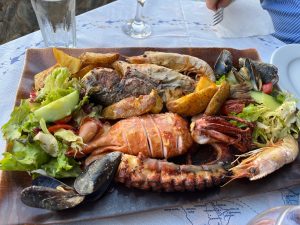Chapter 5: Food Identity

Warm Up Questions
- What kinds of foods are popular in your country? Why are they popular?
- What is one of your favourite dishes? What do you like about it?
- What are some of the factors that influence our food choices?
Key Terms
belief
a way of thinking based on cultural or personal faith, morality, or values that may not be based on fact
fact
information that is verifiable and based on evidence
opinion
a judgement, conclusion, or way of thinking based on facts
prejudice
beliefs that are based on biased information and can be disproven
Reading
1. What we eat—and don’t eat—is influenced by who we are and where we live. Our individual food choices are influenced, for example, by what foods are grown or sold in our geographic regions, by what foods our caregivers served when we were infants, and by the foods eaten by our friends in our social sphere while we were growing up.
2. Our food choices are also influenced by our values, wealth, and social trends. The many layers of our own identities give unique meaning to food and, collectively, give rise to food culture. Therefore, understanding food culture requires an analysis of one’s own perspective of personal, community, and societal values, assumptions, norms, and biases.
3. Our perspectives are a combination of our upbringing, informed by our unique personal identities and experiences. Over time, they become a lens that has an impact on the way we view the world. As we grow, so too does our worldview. Our lenses are dynamic—they are shaped and reshaped as we gather information from new sources and understand information in new ways. Our identities are developed (in part) from various sources of information that we receive consciously and subconsciously. As a result, identity is shaped in ways that we are and are not aware of. We unconsciously integrate information into our worldview—what we think of as “the way the world works.” However, everyone’s world works differently depending on their identity.
4. Individuals’ experiences also differ because they exist in different social, political, geospatial, and historical contexts. The policies, systems, and structures operating in those contexts [give] advantage (or privilege) [to] some identities but not others. In other words, gender identity only matters because societies have, in general, given men more advantages than women. In contrast, other demographic identities, like eye colour, face shape, handedness, and height are not used for social policy making, so they are still identities, albeit relatively harmless ones. Ultimately, identities and the social structures in which an individual lives determine the way their world works and the information they come to know.
What is “Knowing”?
5. We try to be objective, but in reality, we are not unbiased observers. What we know—or what we think we know—is subject to interpretation, to our interpretation through the lens of our personal identities. We must therefore understand our personal identities to distinguish our perspective and how it has an impact on our perceptions. Since our knowledge of food is based on the ways we come to know things, it is up to each of us to be aware of this to better understand ourselves.
6. Information may fall into four categories (Fowler & Aaron, 2011):
- Facts are evidence-based verifiable information, built upon objective reasoning and rooted in science.
- Opinions, or judgements based on facts, are formed in a genuine attempt to draw a conclusion from facts. It is possible to come to different conclusions using the same facts.
- Beliefs are convictions based on cultural or personal faith, morality, or values. In contrast to opinions, beliefs are not necessarily fact-based.
- Prejudices are beliefs based on insufficient, faulty, or biased information, and can be disproved by facts. Bias and stereotypes are forms of prejudice.
7. Each way of knowing is important to understand food culture, and it is important to be able to differentiate between them. For instance, staple foods are usually based on foods that are available within a region (i.e., facts). Using those foods, cultures develop recipes and patterns of eating that produce a pleasant flavour and aroma (i.e., beliefs, based on a sense of smell and taste), which result in some benefit (i.e., opinions, based on relationships between food and health or food cookery), and that are derived from prejudices or biased social stereotypes (i.e., some foods or food practices are condemned while others are valued).
How Personal Identity Shapes Cultural Knowledge

8. Though the development of our personal identities is unique, many commonalities exist between individuals who share characteristics. Those commonalities, or collective identities, give rise to social groups. Dominant social groups tend to dictate cultural norms, values, and assumptions, which become interwoven into the structure of society. For instance, the use of cutlery, chopsticks, or eating with one’s hands differs regionally across the world, depending on the dominant group’s norms and values. Western societies use cutlery because the dominant group is white European and, historically, white Europeans believed that using cutlery was more refined (Goldsmith, 2012).
Conclusion
9. In order to understand the meaning of food, we need to understand our own lens—our personal, community, and societal values, assumptions, norms, and biases. Understanding that lens can enhance self-awareness and reflectively examine what is embedded in our own meanings of food. Assessing our own identities and biases can help facilitate an understanding of other cultures’ food because it helps differentiate among facts, beliefs, opinions, and prejudices. Understanding others’ food culture from their perspective, rather than our own, not only helps in understanding the meaning of food for others, but it also makes each person more culturally humble and able to authentically engage in the world.
(843 words)
Comprehension Questions
- The author lists several ways that our choice of food is influenced. What are two of those influences on food choice?
- The author also lists several ways that we come to view the world. Describe two examples of how our worldview or perspective is shaped.
- Why is it important to consider facts, beliefs, opinions, and prejudices when trying to understand food culture? Give an example for each one as it relates to food.
- How does the dominant social group impact on food culture? Give an example.
- How is an understanding of our own identities and biases helpful in understanding food culture? How is it helpful in relating to other cultures?
Key Vocabulary
albeit
analysis
available
aware
community
conclusion
context
contrast
culture
derive
differentiate
dynamic
facilitate
individual
insufficient
integrate
interpretation
layer
objective
policy
refined
region
source
sphere
Vocabulary Practice
Chapter References
Fowler, H.R., & Aaron, J.E. (2011). The Little, Brown Handbook (12th ed). Boston: Pearson.
Goldsmith, S. (2012, June 21). The rise of the fork. Slate. http://www.slate.com/articles/arts/design/2012/06/the_history_of_the_fork_when_we_started_using_forks_and_how_their_design_changed_over_time_.html
This reading was adapted from Burt, K.G. (2022). Challenging perceptions of food culture and personal identity. In D. Szanto, A. DiBattista, & I. Knezevic (Eds.), Food Studies: Matter, Meaning, Movement, Food Studies Press on Pressbooks. Adaptations include condensing material, reorganizing paragraphs, and creating comprehension questions.

